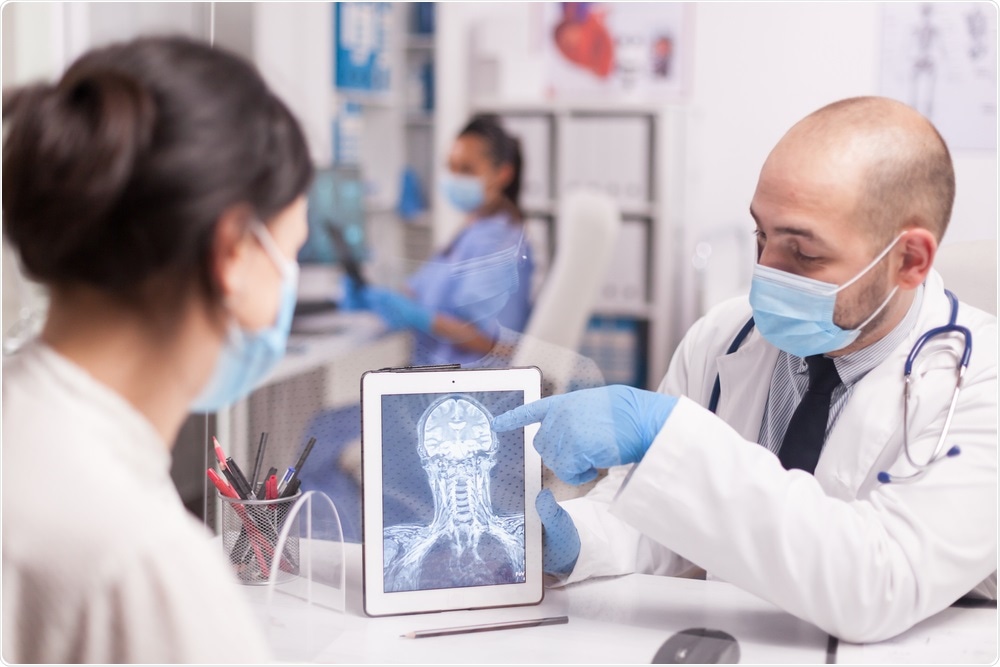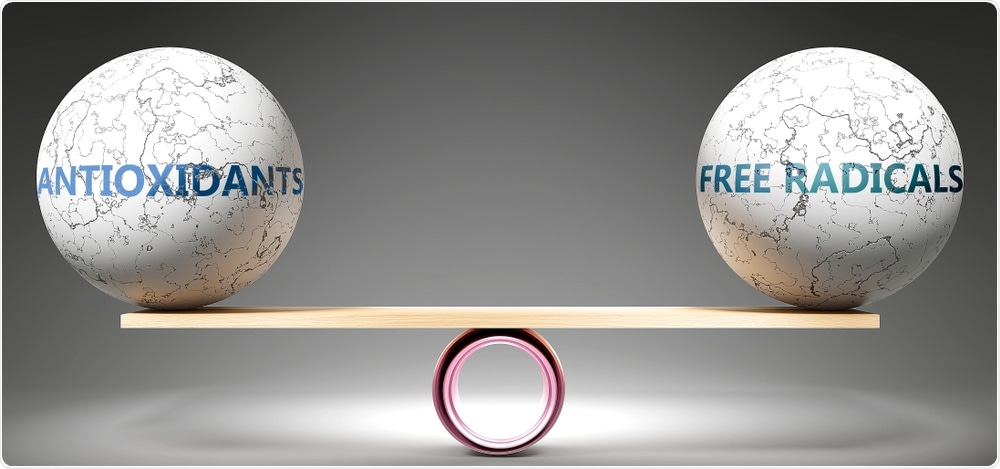Can antioxidants help manage neurological complications in COVID-19?
The severe acute respiratory coronavirus 2 (SARS-CoV-2) has infected almost 180 million people worldwide, with almost 3.9 million people who have succumbed to this virus as of June 22, 2021. The coronavirus disease 2019 (COVID-19), which is the disease that arises following infection by SARS-CoV-2, is widely known for its ability to target the respiratory system. COVID-19 has also been linked to a wide range of neurological manifestations.
In a recent study published in Antioxidants, a group of researchers in Mexico evaluated the use of antioxidants as potential adjuvants for the treatment of COVID-19, with a specific interest in the utility of these agents in reducing or preventing the neurological symptoms of this disease.
 Study: Use of Antioxidants for the Neuro-Therapeutic Management of COVID-19. Image Credit: DC Studio / Shutterstock.com
Study: Use of Antioxidants for the Neuro-Therapeutic Management of COVID-19. Image Credit: DC Studio / Shutterstock.com
Neuropathological variability
Both the transmission of SARS-CoV-2 and its anti-viral treatments can influence the virus’s genetic variability, which can affect the load, virulence, and neuropathological variability of SARS-CoV-2. An example of this can be found within a prevalent variant of the spike (S) protein, D614G, which is associated with a higher viral load in the upper respiratory tract. Notably, however, this variant does not appear to increase the severity of the infection by SARS-CoV-2.
To date, over 5,775 genome variants of the SARS-CoV-2 have been identified. Combined with the fact that new variants are on the rise, more research is required to understand what is responsible for the severe symptoms of COVID-19.
Symptoms
The main symptoms of COVID-19 include fever, shortness of breath, cough, fatigue, and headaches. Some systemic complications of COVID-19 can include adverse respiratory distress syndrome, cardiac injury, acute kidney injury, as well as additional damage to the central nervous system (CNS).
During the initial neurological characterization of COVID-19 during a Wuhan study, a low incidence of neurological complications was reported, which included headaches, nausea, and vomiting, to name a few. However, recent COVID-19 studies have found that neurological symptoms can affect more than 35% of COVID-19 patients, thus demonstrating the possible neuro-invasive side effects of the infection.
The neurological effects of COVID-19 such as anosmia, or lack of smell, can be frequent. However, more severe neurological manifestations such as strokes and encephalopathies have also been reported, although this has been less frequent.
Clinical manifestations of the virus
In the current study, the researchers discuss that viruses like SARS-CoV-2 can cause alveolar gas exchange disorders. As a result, this complication can be associated with hypoxia in the CNS through an increase in anaerobic metabolism and edema. The researchers also refer to studies that claim that COVID-19 has also been associated with a low level of red blood cells, which can be linked with reports of abnormal findings of blood vessel damages in various brain areas which have resulted in the occurrence of strokes.
In severe cases of COVID-19, treatment can include mechanical ventilation with intensive care supervision. Due to vascular inflammation being the most common neurological effect of this COVID-19, anticoagulants are often administered for patients who have coagulopathies in order to reduce their risk of stroke.
The role of ROS
Reactive oxygen species (ROS), which are more reactive derivatives of molecular oxygen, include free radicals and non-radicals such as hydrogen peroxide. This derivative of oxygen is integral in viral infections through its role in stimulating the innate immune response by allowing inflammatory cells to migrate through the endothelial barrier.
This can lead to excessive ROS production and is essential for inflammatory diseases to progress within the body. The increase of ROS has also been reported to be associated with severe viral infections due to the role they play in inflammatory processes and the widespread influence of viruses.
The reduced expression and/or activity of antioxidant enzymes can lead to a redox imbalance during viral infections, which can result in oxidative cell damage. This response has been identified in SARS-CoV-2, where increased oxidative stress may arise as a result of an increased movement of neutrophils to infected areas.
This provides evidence for patients who experience more severe symptoms of the COVID-19 infection exhibiting an increase in neutrophil levels and a reduction in lymphocyte levels. This reduction of lymphocyte levels has also been associated with oxidative stress, which further suggests the significance of this factor in the severity levels of SARS-CoV-2 infections.
Several possible reasons for the higher ROS levels in COVID-19 patients have been described. The activation of enzymes such as nicotinamide adenine dinucleotide phosphate (NADPH) oxidase, for example, is usually regulated by the binding of angiotensin II to angiotensin I. However, this pathway is disrupted by SARS-CoV-2, which acts directly on angiotensin II. Other factors that can lead to ROS production may include the release of iron into the bloodstream and mitochondrial dysfunction.
 Image Credit: GoodIdeas / Shutterstock.com
Image Credit: GoodIdeas / Shutterstock.com
Antioxidants
The use of antioxidants in Chinese herbal medicine has been widely studied, with some antiviral effects reported to occur when using these agents following infection by SARS-CoV-2. The antiviral effect of flavonoids, which are secondary plant phenolics, as well as other antioxidants has been explored for their effect on SARS-CoV-2.
These antioxidants have been found to have a positive effect with different antioxidants working in various ways. An example of this is nigellone, which was found to bind parts of the SARS-CoV-2 virus such as the S protein, as well as block inflammatory markers such as interleukin-1 (IL-1) and IL-6. Other effects of antioxidants in the treatment of SARS-CoV-2 include, but are not limited to, the inhibition of viral replication as well as preventing the entry of the virus into the host cell.
As there are no specific antiviral drugs available for SARS-CoV-2, adjuvant therapies can be useful in treating COVID-19. Antioxidant compounds also have the potential to improve the prognosis of COVID-19 infections. With the ability to reduce inflammation, the researchers discuss the potential utility of incorporating dietary antioxidants into a COVID-19 patient’s treatment plan.
Some of the specific dietary antioxidants that could have a therapeutic effect include vitamins A, C, D, B6, and B12, folate, zinc, iron, copper, and selenium, as each of these micronutrients have a role in the immune response. These vitamins, particularly vitamin C, have also been shown to have an effect on COVID-19 infections.
Other antioxidants such as melatonin, which is a neuro-hormone, have been suggested to be effective in the treatment of the neurological manifestations of COVID-19. More specifically, melatonin has been shown to act as a protectant for neurons and exert anti-inflammatory effects. Other neurological protectants can also help the recovery after brain injuries due to ischemia.
Neurological management is an essential component of COVID-19 treatment. To this end, the use of antioxidants to reduce the inflammatory response while simultaneously working as a neuro-protectant could support their use as adjuvants in treating SARS-CoV-2, especially as new variants of SARS-CoV-2 continue to emerge around the world.
- Cárdenas-Rodríguez, N., Bandala, C., Vanoye-Carlo, A., et al. (2021). Use of Antioxidants for the Neuro-Therapeutic Management of COVID-19. Antioxidants, 10(6). doi:10.3390/antiox10060971. https://www.mdpi.com/2076-3921/10/6/971/htm.
Posted in: Medical Science News | Disease/Infection News | Healthcare News
Tags: Acute Kidney Injury, Adenine, Angiotensin, Anosmia, Anti-Inflammatory, Antioxidant, Blood, Blood Vessel, Brain, Cell, Central Nervous System, Chinese Herbal Medicine, Copper, Coronavirus, Coronavirus Disease COVID-19, Cough, Drugs, Edema, Fatigue, Fever, Free Radicals, Genetic, Genome, Hormone, Hydrogen Peroxide, Hypoxia, Immune Response, Inflammation, Intensive Care, Kidney, Lymphocyte, Medicine, Melatonin, Metabolism, Nausea, Nervous System, Neurons, Neutrophils, Oxidative Stress, Oxygen, Protein, Red Blood Cells, Research, Respiratory, SARS, SARS-CoV-2, Selenium, Severe Acute Respiratory, Stress, Stroke, Syndrome, Vascular, Virus, Vitamin C, Vitamins, Vomiting, Zinc

Written by
Marzia Khan
Marzia Khan is a lover of scientific research and innovation. She immerses herself in literature and novel therapeutics which she does through her position on the Royal Free Ethical Review Board. Marzia has a MSc in Nanotechnology and Regenerative Medicine as well as a BSc in Biomedical Sciences. She is currently working in the NHS and is engaging in a scientific innovation program.
Source: Read Full Article
